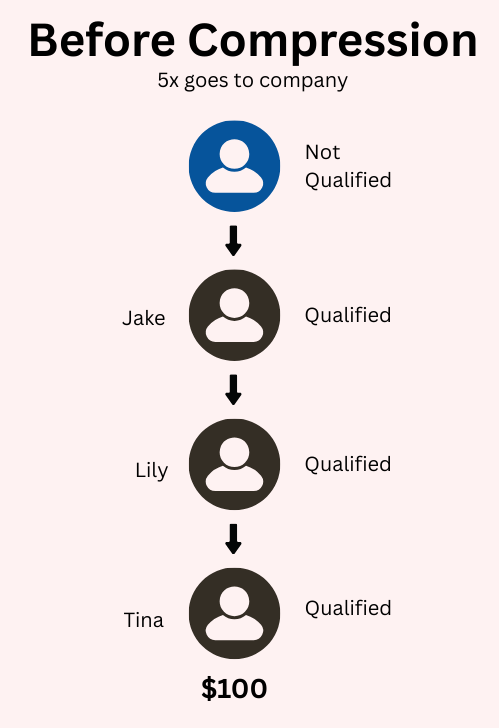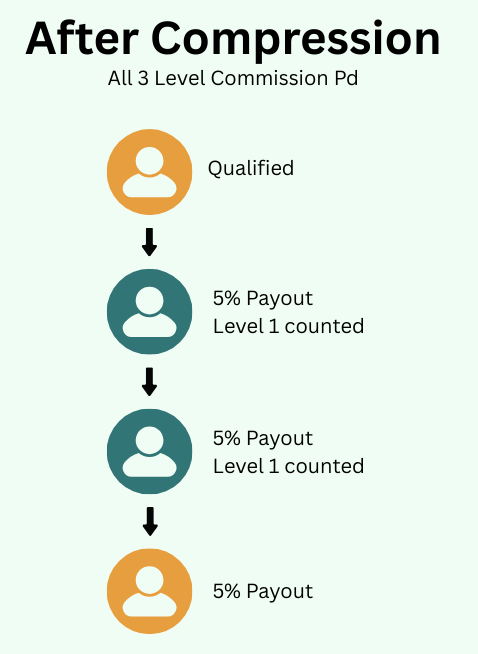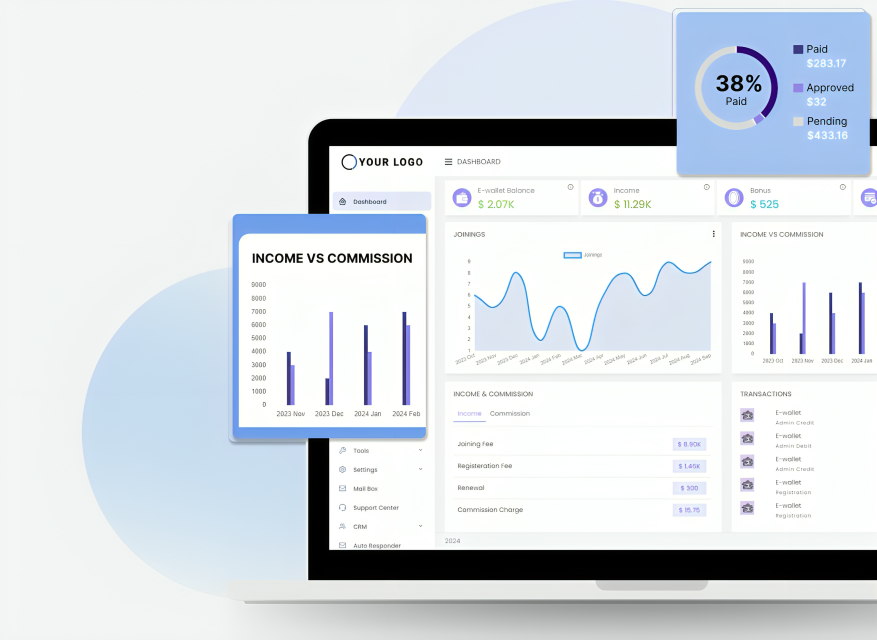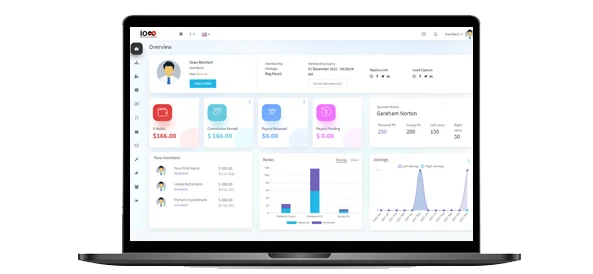Over 40% of MLM distributors go inactive within a year, leaving gaps that block payouts.
So, what happens to their commissions?
And how do you ensure active members don’t lose out?
That’s where compression logic comes in.
Compression logic in MLM software is a mechanism
designed to maintain fairness in commission payouts, especially when some distributors become
inactive.
It automatically skips non-qualifying members and shifts the next eligible ones
upward, closing gaps and maximizing payout efficiency.
Understanding Compression in MLM Software
What is Compression and Why Does It Matter?
Compression in MLM software is the process of removing inactive or unqualified members from commission calculations. When someone doesn’t meet sales or activity thresholds, their position is “compressed,” skipping them for payouts and allowing eligible downline members to move up temporarily in the commission structure. This ensures fair earnings distribution and avoids payout blocks caused by inactivity. Without compression, entire levels of potential commissions and bonuses can be lost, leading to dissatisfaction and inefficiency across the network.
Impact of Inactive Distributors on Network Growth and Earnings
Inactive members dilute network potential. They occupy positions that should generate revenue but instead act as barriers to commission flow. Over time, this not only reduces individual earnings but also affects the morale of active distributors. When earnings drop due to inactive links, engaged members may lose motivation, increasing attrition. Compression logic actively counters this by ensuring active efforts are rewarded, which is vital for sustaining momentum and trust in your MLM program. Compression helps ensure active contributors benefit, vital for MLM business sustainability and customer experience.
How Compression Enhances Commission Accuracy?
Identifying Inactive or Non-Qualifying Team Members
MLM software typically defines “inactive” based on rules set by the business, such as no sales in the past 30 days, failure to meet volume targets, or lack of new recruits. These non-qualifying members are automatically flagged during commission runs. Compression logic uses this status to determine who should be bypassed to maintain reward continuity.
Mechanism of Compression: Closing Gaps in the Downline
Once an inactive distributor is detected, the software compresses the structure by skipping them during auto payout calculation. The next qualified member is pulled up to take their place in that cycle’s commission matrix, without changing the actual hierarchy. This keeps commission chains intact and maximizes earning potential across levels, especially in compensation plans where depth matters (like Unilevel or Matrix models).
Compression in MLM: How It Prevents Commission Loss
Compression is a technique used in MLM plans to skip over inactive or non-qualified distributors during commission payouts. This ensures commissions are not lost and are instead paid to qualified members.
Example:
You sponsor Jake.
Jake recruits Lily.
Lily brings in Mark.
Mark signs up Tina.
Now, here’s what happens:
-
Jake is not qualified to receive commissions.
-
Lily, Mark, and Tina are qualified.
-
Tina makes a sale worth $100.
Before Compression
Even though the structure has three levels:
-
Level 1 (Jake) is inactive and cannot receive the 5% commission.
-
Lily (Level 2) gets 5%.
-
Mark (Level 3) gets 5%.
-
The 5% for Level 1 is lost and retained by the company.
-
Total commission paid: 10%
-
5% is lost due to Jake’s inactive status.

After Compression
With compression applied:
-
Jake is skipped during payout.
-
Lily is moved up to Level 1.
-
Mark becomes Level 2.
-
The next qualified upline after Mark takes Level 3.
-
Each of the three qualified members receives 5%.
-
Total commission paid: 15%
-
No commission is lost.

Note: The structural hierarchy remains unchanged in reports. However, during commission payouts, non-qualified members are bypassed to ensure the full value of commissions is distributed among active participants.
Temporary Path Adjustment vs. Permanent Genealogy Changes
Compression does not change the core genealogy of your MLM network. The skipped positions remain part of the tree but are ignored temporarily during specific payout cycles. This ensures that when inactive members return or regain qualification, they re-enter commission eligibility without disrupting the structure. It’s a smart, reversible logic layer, not a permanent reshuffle.
Still Paying the Price for Inactive Distributors?
Compression logic redirects payouts to those who deserve them, instantly. Maximize reward accuracy, reduce attrition, and boost morale with smart automation.
See Compression in Action –Book a DemoDifferent Compression Techniques in MLM Compensation Plans
Compression in MLM plans ensures fair payout distribution by bypassing inactive or unqualified members and rewarding eligible uplines or downlines more accurately. There are four widely used compression types:
1. Static Compression
Definition:
Static Compression refers to a method of temporarily adjusting the downline tree at the time of commission calculation. It skips inactive or unqualified members only for that specific payout run, without altering the actual genealogy.
How it works:
- The system identifies inactive/unqualified members and removes them temporarily during that commission cycle.
- Qualified members below them are moved up for calculation purposes only.
- On the next commission cycle, the activity is re-evaluated, and compression may change.
- The original downline structure remains unchanged.
Example:
A 3-level payout plan has Levels 1 and 2 inactive, and Level 3 is qualified.
- Without compression, the upline misses the commission from Level 3.
- With static compression, Level 3 temporarily replaces Levels 1 and 2 in the payout position.
Key Points:
- Commission-specific and recalculated each cycle.
- Non-permanent, ideal for preserving genealogy integrity.
- Works best in plans with limited payout levels.
2. Dynamic Compression
Definition:
Dynamic Compression permanently skips inactive or unqualified distributors in every payout run, dynamically moving eligible members upward to maximize full active-level payouts, regardless of the depth required.
How it works:
- Each cycle, the system removes all unqualified members.
- Qualified members below are moved up to fill the active payout slots.
- Compression adjusts the depth dynamically to maintain a full qualified payout, often exceeding level limits.
Example:
In a plan that pays 5 levels:
-
if Levels 2 and 4 are inactive
-
the system skips them and pays Levels 1, 3, 5, 6, and 7, ensuring five qualified levels are paid.
Key Points:
- Dynamic and continuous with every payout.
- Ensures maximum payout efficiency to active distributors.
- Suitable for volume-based or deep-tiered plans.
- Promotes ongoing distributor activity and network-wide fairness.
3. Roll-Up Compression
Definition:
Roll-Up Compression moves commissions upward in the tree until it finds a qualified upline when someone below is inactive or unqualified. The commission “rolls up” the hierarchy, often used in binary, stair-step, or fast-start plans.
How it works:
- If a distributor doesn’t qualify, their commission is not lost; it is given to the next eligible person above.
- This continues up the upline until a qualified distributor is found.
- No levels are skipped; the payout just climbs until someone qualifies.
Example:
Distributor D makes a sale. B and C (above them) are unqualified.
-
Instead of losing commissions, they roll up to Distributor A, who is qualified.
Key Points:
- Ensures commissions are always paid to a qualified person.
- Promotes upline qualification accountability.
- Simple and effective in non-level-capped structures.
4. Selective Level Compression
Definition:
Selective Level Compression honors the level-based payout structure (e.g., 3 levels), but only counts qualified distributors when determining who gets paid. If a level has an inactive member, the system skips them, but doesn’t extend the payout beyond the defined depth.
How it works:
- The system scans within the fixed level limit and only counts qualified distributors.
- Inactive or unqualified members within these levels are skipped.
- The rewards are reallocated to active members within the same level depth.
Example:
In a 3-level payout plan
-
Levels 1 and 2 are unqualified
-
Level 3 is qualified and receives the payout.
-
Levels beyond 3 are not considered, even if more are qualified.
Key Points:
- Respects level-specific rewards and fixed depth rules.
- Doesn’t extend the payout tree like dynamic compression.
- Ensures qualified members are rewarded within their level bounds.
- Ideal for plans with fixed-level commissions or bonuses.
Summary Comparison Table
| Compression Type | Permanent | Level Flexibility | Genealogy Structure | Best Use Case |
|---|---|---|---|---|
| Static Compression | No | Limited (e.g., 3 levels) | Preserved | Fixed-level plans needing genealogy accuracy |
| Dynamic Compression | Yes | Unlimited | Adjusted each cycle | Deep-volume or fast-scaling MLM plans |
| Roll-Up Compression | Yes | Unlimited upward | Preserved | Binary, Stair-step, or Fast-start bonus plans |
| Selective Level Compression | Yes | Fixed levels only | Preserved | Level-bonus plans with qualification filters |
Business Benefits of Implementing Compression Logic
Compression logic isn’t just about filling gaps. It delivers long-term value and operational efficiency across your MLM network.
- Ensures fair and continuous commission flow: By skipping inactive members, compression ensures that commissions reach active, qualified distributors. This keeps payouts accurate and aligned with actual performance.
- Motivates active distributors: When effort is rewarded consistently, it builds trust. Compression prevents hard-working members from missing out due to inactive downlines, helping retain top performers.
- Strengthens network performance: Leaders are encouraged to maintain active teams instead of simply building wide networks. This results in a healthier, more sustainable growth model.
- Reduces payout disputes and support load: Fewer calculation errors mean fewer commission-related complaints. Automated compression helps minimize manual interventions and simplifies backend operations.
- Enhances financial efficiency: Only eligible members receive payouts, preventing unnecessary spending and improving overall profitability.
- Supports better forecasting and planning: By reflecting actual engagement and earnings potential, compression gives a clearer picture of network health. This helps in setting goals and making data-driven decisions.
- Builds long-term trust in the system: Members value transparency. When only those who perform receive payouts, it promotes fairness, accountability, and long-term loyalty.
Fix Commission Loss Before It Costs You!
One skipped payout can kill trust. Compression makes sure that never happens. Prevent leakage, preserve payout chains, and protect distributor loyalty.
Get a Free Compression AuditSetting Up Compression Rules: Best Practices
Establishing the right compression rules is key to ensuring fair and efficient commission payouts. These best practices help align your logic with real-world distributor behavior and your compensation model.
Defining clear qualification and activity criteria
Set clear benchmarks for what makes a distributor "active"; such as minimum personal sales, team volume, or login frequency. This avoids ambiguity and ensures fair application of compression.
Ensuring transparency and fairness in compression application
Make your compression policy part of the compensation plan documentation. Provide visibility in the dashboard so users can track their activity status and understand when compression is triggered.
Real-time data processing and commission recalculation
Use automation to track activity and process commissions in real time. This reduces delays and ensures distributors are rewarded based on current, not outdated, statuses.
Aligning compression logic with overall compensation strategy
Design compression rules that support your payout priorities. For example, if leadership bonuses depend on width, ensure compression doesn't unintentionally flatten structures by over-prioritizing depth.
Setting compression limits and eligibility caps
Define the number of levels compression can apply to (e.g., only compress up to 3 levels deep). This prevents unbounded payouts and aligns with your compensation control limits.
Testing rules with simulation before going live
Always simulate commission runs with test data to identify errors in logic, misapplied rules, or unintended payout behaviors before applying compression live.
Technical Considerations for MLM Software Developers
Implementing compression isn’t just a business decision, it’s a technical challenge. Developers must ensure the logic runs efficiently, integrates well, and scales with network growth.
Performance optimization and resource management
Compression logic must process large downlines quickly. Use asynchronous processes, optimized queries, and background jobs to reduce latency during commission runs.
Audit trails and reporting for compression events
Maintain a detailed log of each compression event. Record the inactive member skipped, the qualifying replacement, and timestamp. This helps with audit, data security, legal protection, and distributor inquiries.
Integrating compression with other software modules
Ensure compression rules factor in data from CRM (activity status), inventory (product qualification), and e-wallets (available balance). Smooth API integrations prevent data mismatch across modules. Link compression logic with your mobile apps, and payment gateway systems to ensure payout readiness.
Designing flexible compression settings
Build admin-level tools that allow plan owners to change compression settings (e.g., enable/disable dynamic compression, adjust inactivity period) without hardcoding logic.
Ensuring scalability for growing networks
As MLM networks grow, software must scale. Use architecture that supports deep-level compression without performance drop, especially for large international downlines.
Challenges and Solutions in Compression Implementation
While compression solves many payout issues, it brings its own operational challenges. Here are common hurdles along with practical solutions to keep your system accurate and fair.
| Challenge | Description | Solution |
|---|---|---|
| Frequent Status Changes | Distributors may toggle between active and inactive mid-cycle, leading to commission miscalculations. | Use real-time tracking with status caching. Lock eligibility at key cutoff points (e.g., end of the commission period) to avoid recalculations. |
| Over-Compression Risks | Aggressive compression can unfairly skip members and inflate payouts or flatten the structure. | Set compression caps (e.g., max 3 levels). Compress only within defined payout ranges and validate rules based on the plan type. |
| Inconsistent Application | Uniform compression logic doesn’t fit all plans like Binary, Unilevel, or Matrix. | Configure compression rules uniquely per plan. Use modular logic that adapts to each compensation structure. |
| Lack of Clarity | Distributors may not understand how or why compression impacted their payouts. | Offer detailed payout logs with visual breakdowns and clear compression explanations in the user dashboard. |
| Increased System Load | Deep compression in big networks can slow down processing times during large commission runs. | Use scalable infrastructure, job queues, and batch processing. Run calculations during off-peak hours. |
| Disputes & Legal Exposure | Unclear or inconsistently applied rules can trigger disputes or legal issues. | Clearly document compression policies in the compensation plan. Maintain audit logs and ensure legal compliance. |
Emerging Trends and Future Directions in MLM Compression
MLM compression is evolving from static rules to smarter, more flexible systems. New technologies are making it easier to apply compression fairly, in real time, and with greater transparency.
- AI and Machine Learning for Smarter Compression Decisions: AI helps automate and refine compression by learning from distributor behavior. It ensures decisions are timely, fair, and optimized for network performance. AI and chatbots in MLM help automate and optimize compression cycles.
- Predictive Analytics to Forecast Compression Impact: Forecasting tools simulate the downstream effects of compression changes. This lets companies adjust rules before implementation, avoiding payout shocks.
- Enhanced Visualization and Transparency Tools for Distributors: Distributors now expect clear, real-time views of their structure. Visual dashboards show compression effects and build trust through transparency.
- Real-Time Compression Engines: Batch updates are being replaced by real-time recalculations. These engines instantly reflect network changes for accurate, up-to-date commissions.
- Customizable Compression Rules by Plan Type: One-size-fits-all no longer works. Modern systems allow different compression rules for different plan types within the same platform.
- Compression Triggers Based on Multi-Metric Activity: Activity status is no longer binary. Systems now consider multiple engagement metrics before triggering compression for better accuracy.
- Audit-Ready Compression Logs and Compliance Tools: With growing legal scrutiny, MLM software now includes detailed logs. These tools ensure every compression action is trackable and compliant.
In Summary
Compression logic is essential for maintaining fair, accurate, and efficient commission payouts in MLM networks. By bypassing inactive members and directing earnings to active distributors, it ensures payout continuity, boosts motivation, and supports sustainable growth. Look for MLM software development partners who offer scalable tools, affordable pricing models, and tight integration with eCommerce platforms like Woocommerce, Magento,and Shopify.
Your Structure Stays Intact, But Payouts Flow Smarter!
Compression adjusts the path, not your genealogy. Learn how reversible, rule-based logic can transform how your MLM pays.
Try NowFrequently Asked Questions
No, compression doesn’t permanently alter the genealogy of the network. It only affects the commission path during specific payout cycles. Inactive members are temporarily skipped, but their original position remains intact. If they become active again, they resume eligibility without disrupting the hierarchy.
When a compressed distributor becomes active, the software reconsiders them for future payouts. They are reinstated into commission calculations for upcoming cycles. There's no need for manual re-entry since their genealogy remains untouched. This ensures a smooth, reversible transition based on activity status.
Compression is often customized per bonus type. For example, dynamic compression may apply to team commissions, while static rules might be used for matching bonuses. This ensures that each bonus follows fair payout logic. Businesses can adjust settings for each compensation rule individually.
Without compression, inactive members can block entire levels of commissions, leading to unpaid bonuses or "breakage." Compression redirects those earnings to the next qualified member. This ensures performance is rewarded consistently and that commission pools are fully utilized. It also builds distributor trust.
Static compression skips inactive members only within a fixed level range (e.g., 3 levels). Dynamic compression continues skipping through unlimited levels until it finds a qualified recipient. Dynamic is more flexible and ensures no commissions are lost, especially in deep or fast-growing networks.
In Matrix plans, compression shifts active members up to fill blocked positions while respecting the structure’s width and depth. In Binary plans, compression usually rolls commissions up to the next qualifying sponsor in the weaker leg. Each plan applies compression differently to preserve payout logic.
Yes, most modern MLM systems support real-time or scheduled updates before commission runs. This means if a distributor becomes active or inactive mid-cycle, the software adjusts accordingly. It ensures payouts reflect the latest activity without errors or missed opportunities.
Look for features like customizable compression rules, dynamic/static options, audit logs, dashboard transparency, and scalable processing. Integration with activity tracking, sales reports, and e-wallets is also key. The system should be flexible, secure, and easy for admins to manage.
Distributors lose motivation when their earnings are affected by inactive team members. Compression ensures their efforts are fairly rewarded by bypassing unqualified links. This helps retain top performers, reduces churn, and promotes a culture of active participation across the network.

Experience the world of MLM Software
Boost profits 10x times with Infinite MLM Software.











